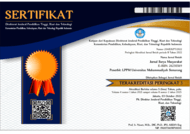Edukasi Konten Digital terhadap Anak Usia Dini di TK Negeri 3 Suryoputran Kota Yogyakarta
(1) Widya Mataram University
(*) Corresponding Author
Abstract
According to the Hootsuite We Are Social report, internet use in Indonesia continues to increase and is higher than the total population. Pierre Levy's perspective with two approaches, namely: social interaction and social integration is also able to show changes in behavior as well as shifts in public activity as a form of adaptation in the current era of disruption. The existence of the internet is like a double-edged sword, especially for groups of children at an early age who are very vulnerable to being exposed to negatively charged information and content, even though this condition has also been regulated in the Information and Electronic Transactions Law / UU ITE. This Community Service Activity is located at TK Negeri 3 Suryoputran Yogyakarta City "by using the lecture method, related questions and answers: (1) early childhood understanding of the scope of the internet and the use of gadgets / smartphones, (2) early childhood understanding of content on social media and the impact that will be obtained, and (3) simulation / playing learning together. The students at the activity location were equipped with a number of important knowledge regarding the use and when is the right time to use a smartphone that is appropriate for their age background. Then, the content, information, and what impacts can be obtained by early childhood children due to excessive internet access were explained as clearly as possible by the facilitators because it departed from the finding that these children were quite fluent in accessing the Google website and several popular social media. everyday. Therefore, it is hoped that there will be complete cooperation from parents and schools to be able to accompany the growth and development of children at this young age, including as a creative and skilled digital generation.
Keywords
Full Text:
PDFReferences
Alia, T., & Irwansyah, I. (2018). Pendampingan orang tua pada anak usia dini dalam penggunaan teknologi digital [parent mentoring of young children in the use of digital technology]. Polyglot: Jurnal Ilmiah, 14(1), 65-78.
Al-Ayouby, M. H. (2017). Dampak penggunaan gadget pada anak usia dini (Studi di PAUD dan TK. Handayani Bandar Lampung). Lampung: Universitas Lampung.
Antaranews.com. 2022. Menyiapkan Generasi Masa Depan dengan Literasi Digital di Era Internet. https://megapolitan.antaranews.com/berita/210321/menyiapkan-generasi-masa-depan-dengan-literasi-digital-di-era-internet. Diakses pada tanggal 3 Desember 2022.
Darmastuti, R., Purnomo, J. T., Utami, B. S., & Yulia, H. (2019). LITERASI MEDIA BERBASIS KEARIFAN LOKAL MASYARAKAT BALI. Jurnal Studi Komunikasi, 3(3), 402. https://doi.org/10.25139/jsk.v3i3.1538.
Feroza, C. S. B., & Misnawati, D. (2020). Penggunaan Media Sosial Instagram Pada Akun@ Yhoophii_official Sebagai Media Komunikasi Dengan Pelanggan. Jurnal Inovasi, 14(1), 32-41.
Hootsuite We Are Social. 2022.Indonesian Digital Report 2022. https://andi.link/hootsuite-we-are-social-indonesian-digital-report-2022/. Diakses pada tanggal 3 Desember 2022.
Kementerian Komunikasi dan Informatika RI, Direktorat Jenderal Aplikasi Informatika. 2020. Orang Tua Agar Awasi Belajar Anak terhadap Bahaya Pornografi. https://aptika.kominfo.go.id/2020/08/orang-tua-agar-awasi-belajar-anak-terhadap-bahaya-pornografi/. Diakses pada tanggal 3 Desember 2022.
_________2023. Indeks Literasi Digital Tahun 2022 Meningkat, Kominfo Tetap Perhatikan Indeks Keamanan. https://www.kominfo.go.id/content/detail/47179/siaran-pers-no-10hmkominfo022023-tentang-indeks-literasi-digital-tahun-2022-meningkat-kominfo-tetap-perhatikan-indeks-keamanan/0/siaran_pers. Diakses pada tanggal 3 Mei 2023.
Nasrullah, R., Aditya, W., & Satya, T. (2017). Materi Pendukung Literasi Digital Gerakan Literasi Nasional. Jakarta : Kementerian Pendidikan dan Kebudayaan.
Ningrum, D. P. (2020). Penanaman nilai kearifan lokal pada anak usia dini di TK Negeri 3 Suryoputran kota yogyakarta. Jurnal Komunikasi Profesional, 4(1).
Noegroho, Agoeng. 2010. Teknologi komunikasi. Yogyakarta:Graha ilmu.
Oktafia, D. P., Triana, N. Y., & Suryani, R. L. (2022). Durasi Penggunaan Gadget Terhadap Personal Sosial Pada Anak Usia Prasekolah: Literatur Review. Borneo Nursing Journal (BNJ), 4(1), 31-47.
Saputri, A. D., & Pambudi, D. A. (2018). Dampak Penggunaan Gadget Terhadap Kemampuan Intraksi Sosial Anak Usia Dini. In Annual Conference on Islamic Early Childhood Education (ACIECE) (Vol. 3, pp. 265-278).
Sindonews.com. 2022. Dunia Digital dan Pembentukan Pengetahuan Generasi Muda. https://nasional.sindonews.com/read/824843/18/dunia-digital-dan-pembentukan pengetahuan-generasi-muda-1657634878. Diakses pada tanggal 3 Desember 2022.
Tirto.id.2018. KemenPPA Usia Ideal Anak Akses Gadget Adalah 13 Tahun. https://tirto.id/kemenpppa-usia-ideal-anak-akses-gadget-adalah-13-tahun-cKJV. Diakses pada tanggal 4 Mei 2023.
______.2020. Manfaat Mewarnai Bagi Anak, Tingkatkan Motorik dan Kreatifitas. https://tirto.id/manfaat-mewarnai-bagi-anak-tingkatkan-motorik-hingga-kreativitas-fHKg. Diakses pada tanggal 3 Maret 2023.
Undang-Undang Nomor. 19 Tahun 2016 tentang Perubahan Undang-Undang Nomor. 11 Tahun 2008 tentang Informasi dan Transaksi Elektronik.
Webster, F. (2006). Theories of information society. London, UK: Routledge. DOI: https://doi.org/10.4324/9780203962824.
Article Metrics
Abstract view : 175 timesPDF - 38 times
DOI: https://doi.org/10.26714/jsm.6.1.2023.31-41
Refbacks
- There are currently no refbacks.
Copyright (c) 2023 Jurnal Surya Masyarakat

Jurnal Surya Masyarakat (JSM) is licensed under Creative Commons Attribution-NonCommercial-NoDerivatives 4.0
------------------------------------------------------------------------------------------------------------------------
Jurnal Surya Masyarakat (JSM)
p-ISSN: 2623-0364; e-ISSN: 2623-0569
Published by: Lembaga Penelitian dan Pengabdian Masyarakat (LPPM) Universitas Muhammadiyah Semarang



.jpg)







.jpg)